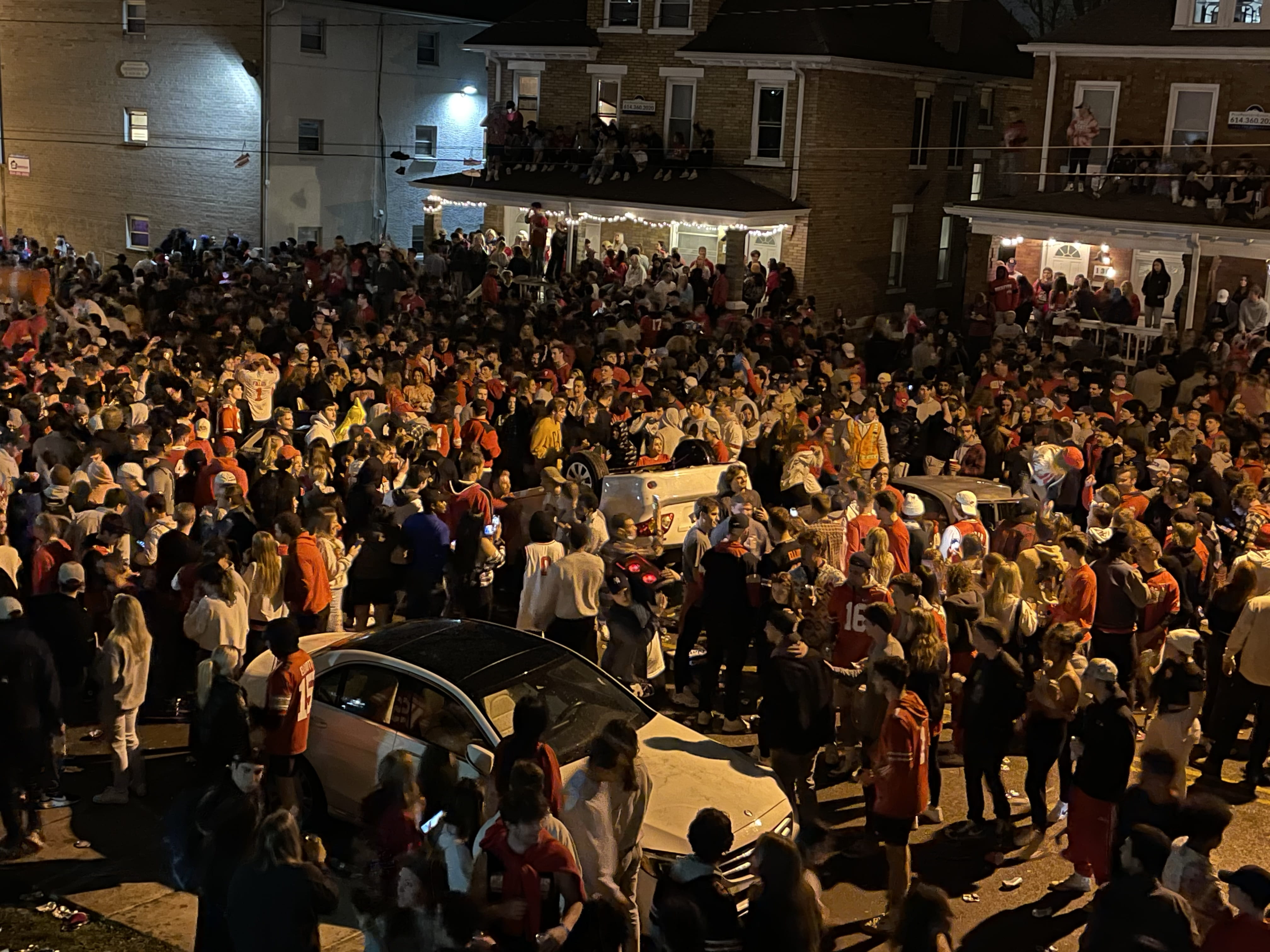
Ohio State students flip a car on Chittenden Avenue. More than a thousand students flocked to the street for an evening that resulted in multiple flipped cars and Columbus Police helicopters being called in, but no arrests were made. Credit: Paige Cirtwill | Lantern Reporter
Two years ago, I attended Chitt Fest in the spring. The event was busy; there were hundreds of people on sidewalks and in the front yards of residences all over Chittenden Avenue. As the night progressed, people began to try to bring the party to the street. Before the party could erupt into chaos, however, dozens of officers from the Columbus Police Department arrived on horseback to keep people on sidewalks and monitor activity down the entire street. A helicopter circled the perimeter the duration of the night and eventually the crowd of partiers dispersed, the only remnants of the night being emptied solo cups, beer bottles and cans.
With this in mind, there is no excuse that the CPD can offer me that is sufficient as to why they did not uphold the safety of the community Saturday night on Chittenden Avenue. There is clearly a precedent that has been set to address off-campus partying, especially on Chittenden. This has been displayed over the years, as Columbus Police show up to house parties and campus-area bars to disperse crowds, prevent chaos and occasionally cite students for drinking underage. The fact that the CPD chose not to uphold this precedent during a pandemic, at one of the largest super spreader events in the university area this year, is dumbfounding.
A Columbus Police dispatcher stated that multiple units responded to calls about the riot, with the first response at 10:42 p.m. However, footage of partying, cars being overturned and a general lack of adherence to COVID-19 guidelines set by the city itself goes well into the night, with anything but a noticeable response from police.
The lack of response to a full-scale off-campus riot happening down the street from a Columbus Police station compared to the overwhelming occupation of North High Street during peaceful protests against racial injustice shows the difference in responses to crime by the CPD based on race. Unconfirmed threats of gang activity that stemmed from racial profiling by students in the off-campus area prompted Columbus Police to monitor the streets nightly, ensuring the safety of these student’s false beliefs. A gathering of a thousand students, mostly unmasked and no one adhering to physical distancing, was met with no force. The criminal destruction of students’ personal property — their means of transportation — did not result in arrests. However, with my own eyes I watched officers pepper-spray and brutalize peaceful protestors in broad daylight in the name of crowd control. I saw hundreds of fully armed, riot-equipped officers march the length of North High Street in a display of sheer force.

More than 1,000 people — primarily Ohio State students — gathered on Chittenden Avenue Saturday for “Chitt Fest.” Police were called to the area at about 10:45 p.m. Credit: Owen Milnes | Campus Producer
The only comparison that can truly be made regarding the year’s protests against racial injustice and the Chitt Fest riot is that in both cases, Columbus Police failed to de-escalate the situation at hand, the former being an example of instances in which they themselves escalate situations through the use of force at peaceful protests. Rather it be out of fear or a general disregard for the safety of the community, the Columbus Police failed to serve and protect the off-campus community both Saturday night and throughout this year. The department flew helicopters over inner city neighborhoods scripting the letters “CPD” last week, only adding to the irony of a general lack of response to a public safety and public health threat happening on the ground. Saturday night was just another example of how Columbus Police will uphold the safety of the privileged, even if it means allowing the privileged to put the rest of the community at risk.
While upholding the privilege of its white students, the university continues to ignore and diminish the struggles of its minority communities. Especially for members of the Black community, the lack of a direct response from the university to Saturday’s events is another example of how racial minorities and their experiences are often devalued by university administrators. Crimes committed by Black people in the off-campus area are met with immediate action and even more immediate public scrutiny, but crimes committed on camera by white students in the same area receive almost no response from police and a delayed reaction from the university.
Though many disapprove of the email that Student Life Vice President Melissa Shivers sent to the student body in regard to the riot, the fact that a Black woman was the first university administrator to even address the issue shows that the Black community is often alone in calling out the university on its lack of attention to or care for the disenfranchised members of the Ohio State and greater Columbus community.
A common response to calls to defund Columbus Police by our student body is that police uphold the safety of the community, and that if the police aren’t present, no one will be there to stop crime — but the crime-stoppers were not present Saturday night. If the CPD fails to function in the most basic capacity, should we depend on them? How can we trust this department to respond appropriately to safety threats in the future? How are disenfranchised students and members of this community supposed to believe that the department is capable of change while continuously being harmed by its actions? These are questions that seem to have obvious answers following Saturday’s events: we shouldn’t, we can’t and we don’t.


